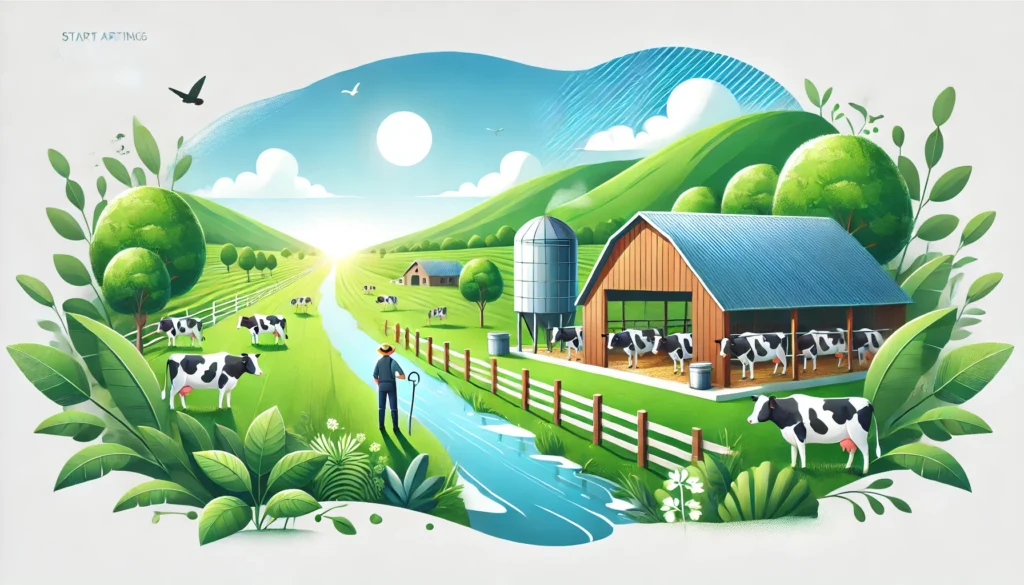
How to Set Up a Dairy Farm in India: A Comprehensive Guide
How to Start a Successful Dairy Farm in India
Dairy farming is one of the most sustainable and lucrative agricultural businesses in India. With the increasing demand for milk and dairy products, establishing a dairy farm can be a profitable venture. However, to succeed, you must plan thoroughly and follow industry best practices. Here’s a step-by-step guide to setting up a dairy farm in India.
1. Conduct Market Research

Market research is critical to understanding the local demand for milk and other dairy products. Urban areas typically prefer pasteurized or low-fat milk, while rural markets may favor raw or high-fat milk. Research competitors in your area, their pricing strategies, and customer preferences. Understanding these dynamics will help you identify your niche in the market.
2. Create a Business Plan
A well-structured business plan will serve as a roadmap for your dairy farm. Key elements include:
- Objectives: Define the purpose of your farm—whether it’s producing raw milk, pasteurized milk, or value-added products like yogurt and cheese.
- Financial Estimates: Calculate the investment required for land, cattle, feed, equipment, and infrastructure. A small-scale farm with 20-25 cattle may require ₹10-20 lakh initially.
- Risk Mitigation: Identify risks such as fluctuating milk prices or cattle health issues and devise strategies to manage them.
3. Choose a Suitable Location
Selecting the right location is crucial. Consider the following factors:
- Land Requirements: Adequate space for cattle sheds, fodder storage, and waste management.
- Accessibility: Easy access to markets and suppliers for milk distribution and feed procurement.
- Water Supply: A reliable source of clean water for both drinking and cleaning purposes.
4. Select High-Yielding Cattle Breeds

Choosing the right cattle breed directly impacts milk production. Popular breeds in India include:
- Indigenous Breeds: Sahiwal, Gir, Red Sindhi.
- Exotic Breeds: Holstein Friesian, Jersey.
Ensure the animals are healthy, vaccinated, and suited to your farm’s climatic conditions.
5. Build Necessary Infrastructure
Proper infrastructure is key to maintaining animal health and ensuring efficient operations. Include:
- Housing: Design well-ventilated and spacious sheds. For instance, a cow requires approximately 40 sq. ft. of covered area and 80 sq. ft. of open space.
- Milking Parlor: Set up a clean and organized area for milking to maintain hygiene.
- Storage: Provide facilities for storing feed, fodder, and milk.
6. Focus on Feeding and Nutrition
A balanced diet is essential for high milk yield. Plan a mix of green fodder, dry fodder, and concentrates. Cultivating your own fodder crops, like maize or sorghum, can reduce costs. Ensure cattle have continuous access to clean water to maintain health and productivity.
7. Ensure Animal Health and Breeding Management

Health management is integral to sustainable dairy farming. Arrange for regular veterinary checkups, vaccinations, and treatments for common diseases like foot-and-mouth disease. Implement efficient breeding programs to ensure the longevity and productivity of your herd.
8. Obtain Licenses and Permits
To operate legally, you’ll need to acquire necessary approvals, including:
- FSSAI Registration: Mandatory for food businesses in India.
- Local Permits: Obtain trade licenses and comply with environmental norms.
9. Explore Financial Assistance and Subsidies
Dairy farmers can benefit from several government schemes:
- NABARD Schemes: The Dairy Entrepreneurship Development Scheme (DEDS) offers subsidies for setting up dairy farms.
- Bank Loans: Many banks provide loans specifically for agricultural ventures.
These financial aids can reduce the burden of initial investments.
10. Implement Waste Management Systems
Proper waste management not only helps maintain cleanliness but also creates additional revenue streams:
- Manure Utilization: Use cattle dung for biogas production or as organic fertilizer.
- Sustainability Practices: Install rainwater harvesting systems and energy-efficient equipment.
11. Develop a Marketing Strategy
Effective marketing ensures your products reach the right audience. Consider:
- Direct Selling: Partner with local retailers or set up your own outlets.
- Value Addition: Produce and sell ghee, paneer, or flavored milk to attract diverse customers.
- Online Platforms: Leverage e-commerce platforms for broader market access.
12. Challenges and Solutions in Dairy Farming
Common challenges in dairy farming include fluctuating feed prices, disease outbreaks, and market competition. Address these by:
- Using bulk purchasing strategies for feed.
- Building a network of reliable veterinarians.
- Exploring niche markets, such as organic or A2 milk production.
Conclusion
Setting up a dairy farm in India requires careful planning, investment, and management. By choosing the right breeds, maintaining proper infrastructure, and adhering to sustainable practices, you can build a profitable and long-term business. Stay updated with advancements in dairy technology and industry trends to continuously improve your operations.
Dairy farming is not just a business; it’s a way to contribute to India’s agricultural and nutritional landscape. With dedication and smart planning, you can make it a rewarding endeavor.



